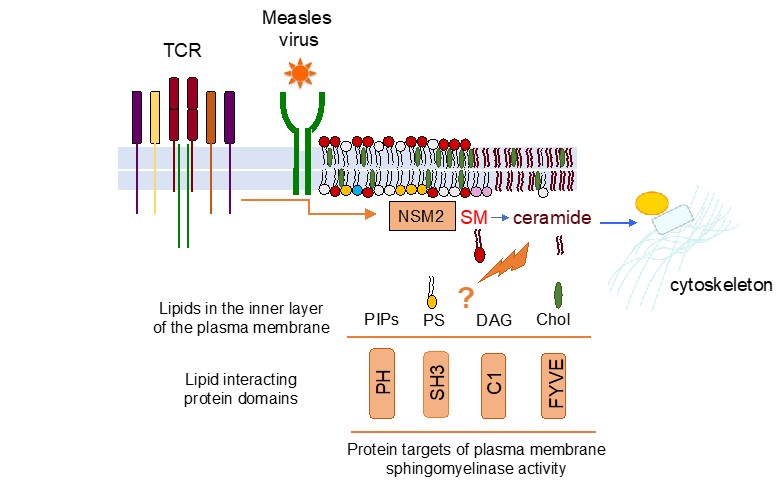Projects
Elita Avota (Research) Sphingolipid metabolism in measles virus immunosuppression
Immunomodulatory capacity of measles virus (MV) activated sphingomyelinases in T cell compartment is the main research focus in our group. Currently we are investigating the role of MV-induced and sphingomyelinase dependent modulation of lipids and lipid-regulated protein topology at the plasma membrane of T cells as the part of immune response modulation by MV. Recently, we have performed lipidomic analysis of plasma membranes isolated from neutral sphingomyelinase 2 (NSM2) deficient T cell line revealing the profound role of NSM2 in homeostasis of important membrane integral and signaling lipids: cholesterol and diacylglycerol (DAG). Further on, perturbations in cholesterol homeostasis in NSM2 deficient cells are leading to the accumulation of intracellular and plasma membrane cholesterol, which is related to the higher sensitivity of T cells towards lipid diet.
Besides plasma membrane related lipid changes NSM2 deficient T cells have impaired mitochondria morphology and functionality and are not able to mount the energy source switch from oxidative phosphorylation in motochondria to glycolysis upon T cell receptor (TCR) stimulation.
How the sphingolipid changes in outer cellular membranes translate into suppressive (induced by MV contact) or stimulatory (induced by TCR antigenic stimulation) intracellular signals in immune system is the central question of the current project.
Project related methods:
- Human T cell sphingomyelinase activity assays and lipid content analysis of T cell plasma membrane and profiling of different T cell subsets after T cell receptor (TCR) stimulation or MV contact
- Plasma membrane protein and lipid visualization by confocal microscopy including usage of functionalized synthetic sphingolipids.
- Measurement of metabolic activity and lipid content in sphingomyelinase deficient T cells
- CrispR/Cas9 mediated genetic modification of T cell lines.







